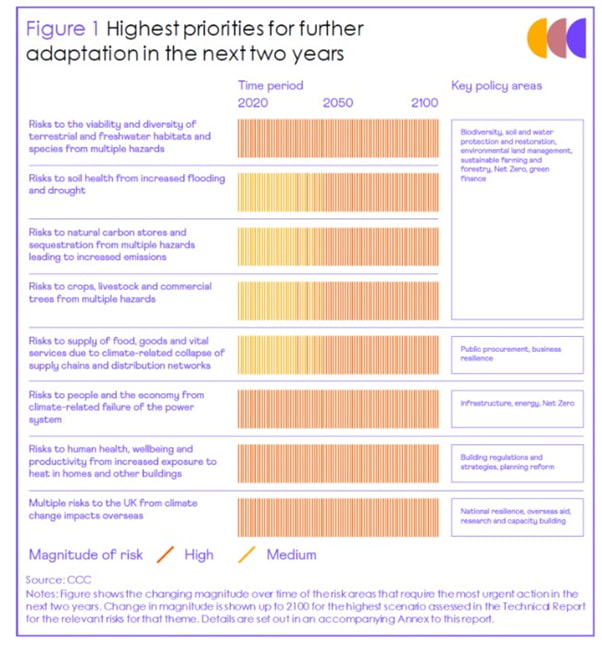In an age of human-induced climate change, extreme weather risk management knowledge and skills are necessary for construction professionals.
The growing problem of severe weather
Adverse weather events, including extreme weather phenomena such as hurricanes, floods, and droughts, pose a significant threat to the safety of construction workers and projects. For example, some of the risks identified by the UK's Climate Change Committee directly affect the construction industry's safety, productivity and profitability, as noted below:

(Image source: theccc.org.uk)
- Increased flooding and drought have several adverse outcomes, such as a higher risk of failure during construction, building damage, and landslides.
- High winds due to tree cover loss can damage scaffolding, roofs and other structures and delay construction.
- Extreme temperatures, such as the recent unprecedented +40C heatwave in the UK, cause worker fatigue. When the temperatures dip below freezing, weathering of concrete can occur, and there are problems with insulation.
As climate change continues to drive more severe weather patterns across the globe, construction professionals need to understand how they can mitigate weather risk.
Challenges of assessing extreme weather risk factors
Understanding weather management risk is a complex task, as weather patterns vary significantly in different regions and weather events come with their own unique safety hazards. Below are some of the challenges of assessing weather risk factors.
Lack of historical data
Even though they are happening more frequently, severe weather occurrences are, by definition, rare events – so there is often little data available to help assess the risks associated with them. This lack of data can make it challenging to develop accurate models to predict the likelihood and impact of extreme weather occurrences.
The complexity of weather systems
The Earth's atmosphere is a complex system with many different variables that can affect the formation and behaviour of extreme weather events. This complexity makes it difficult to develop models that accurately predict how these events will occur and their impacts.
Uncertainty in climate change projections
Climate change is expected to increase the frequency and intensity of adverse weather events in many parts of the world. However, there is significant uncertainty and many different projections about how much the climate will change in the future and what specific impacts this will have on extreme weather events. This uncertainty makes it difficult to account for climate change when assessing the construction risks associated with harsh weather events.
Difficulty in measuring risk
Risk is often measured in probability, and construction is no exception. However, estimating the likelihood of an extreme weather event occurring can be difficult due to the limited data available and the complex nature of atmospheric systems.
Limited resources
Assessing risk requires access to data, computer models, and other resources that can be expensive and may not be available to small and medium-sized construction companies.
Inadequate warning systems
Many regions do not have adequate warning systems to alert people when an event is likely to occur. Warning systems are critical for allowing construction companies and the general populace to take steps to protect themselves from an impending event, but they require both accurate predictions and effective communication channels.
Weather risk management plan
A weather risk management plan is an essential tool for construction professionals to protect their projects, personnel, and equipment. Below are some of the key elements:
Develop weather monitoring systems
The first step in weather risk management is to develop weather monitoring systems that allow construction companies to monitor weather conditions and forecasts. This will enable them to track the weather daily and be aware of longer-term weather trends and forecasts. Weather information is available from several sources, such as the UK Met Office, weather satellites, weather stations, weather forecasts, and local climate experts.
Develop weather risk assessment models
Weather risk assessment models are essential for helping construction professionals understand the likelihood and potential impacts of weather events. Risk assessment models allow construction professionals to predict weather conditions, assess the probability of an event occurring, and develop plans for how to respond when an extreme weather event occurs.
Establish weather warning and alert systems
Weather warning and alert systems are essential for keeping construction personnel and the general public safe when harsh weather events occur. These systems should be able to provide timely and accurate weather forecasts and notifications of potential weather events in the form of alerts and warnings.
Develop weather emergency response plans
Weather emergency response plans provide the framework for responding to weather disasters. These plans should include procedures for identifying weather hazards, assessing weather risk factors, and providing guidance on how to react when a weather event occurs.
Staff and public risk management plan
Construction personnel are especially vulnerable to weather-related risks, so it is critical to develop plans that address the specific safety needs of your personnel and the public. This includes developing weather risk awareness campaigns, providing weather safety training for staff and contractors, and personal protective gear.
Weather insurance
Finally, weather insurance is vital for protecting construction projects from weather-related losses. Weather insurance can provide financial protection against weather-related losses, such as property damage or supply chain disruption.
The Role of Weather Risk Management Platforms
Weather risk management platforms, such as the EHAB Risk Management Platform, can help construction professionals quickly and effectively assess weather risks and develop weather risk contingency plans.
EHAB empowers planning teams with hyper-local climate-adjusted datasets, machine learning and industry-specific planning features. With the EHAB weather risk management platform, construction companies and professionals can effectively plan construction projects, avoid down days, improve client relationships, and enjoy better bottom lines.
Sign up for a 30-minute demo of the EHAB Risk Management Platform to learn more about how it can help you manage weather risks on your construction projects.




